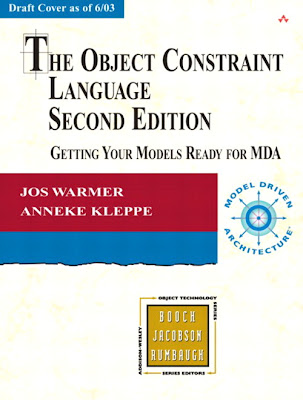
Object Constraint Language, The: Getting Your Models Ready for MDA, Second Edition
By Jos Warmer, Anneke Kleppe
Publisher : Addison Wesley
Pub Date : August 29, 2003
ISBN : 0-321-17936-6
Pages : 240
"In this thoroughly revised edition, Jos and Anneke offer a concise, pragmatic, and pedagogic explanation of the Object Constraint Language (OCL) and its different applications. Their discussion of OCL's potential role in Model Driven Architecture (MDA) is timely and offers great insight into the way that UML can be taken to the next level of automated software development practice. I highly recommend this book to anyone who is looking to get the most out of UML"
-Shane Sendall, Ph.D.Senior ResearcherSwiss Federal Institute of Technology in Lausanne
The release of Unified Modeling Language (UML) 2.0 places renewed emphasis on the Object Constraint Language (OCL). Within UML, OCL is the standard for specifying expressions that add vital information to object-oriented models and other object-modeling artifacts. Model-Driven Architecture (MDA) relies on OCL to add the level of programming detail necessary to enable Platform-Specific Models (PSM) to communicate with Platform-Independent Models (PIM).
This book is a practical, accessible guide to OCL for software architects, designers, and developers. Much care has been taken during the redesign of OCL to ensure that the syntax remains readable and writable by the average software modeler. The Object Constraint Language, Second Edition, utilizes a case study to show how to exercise these compact but powerful expressions for maximum effect.
This newly updated edition also
* Explains why OCL is critical to MDA-and why UML alone is not enough
* Introduces an SQL-like syntax to OCL
* Defines the new language constructs of OCL 2.0
* Demonstrates how OCL can be incorporated into code
* Shares tips and tricks for applying OCL to real-world modeling challenges-showing which can be solved with UML and which require OCL
Using a combination of UML and OCL allows developers to realize the effective, consistent, and coherent models that are critical to working with MDA. The authors' pragmatic approach and illustrative use of examples will help application developers come quickly up to speed with this impotant object-modeling method--and will serve as a ready reference thereafter.
Copyright
Praise for The Object Constraint Language, Second Edition
The Addison-Wesley Object Technology Series
The Component Software Series
List of Figures
List of Tables
Foreword to the First Edition
Foreword to the Second Edition
Preface and Introduction
Who Should Read This Book
How This Book Should Be Used
Typeface Conventions
Information on Related Subjects
Acknowledgments
Part 1. User Manual
Chapter 1. MDA and the Use of OCL
Section 1.1. Introducing OCL
Section 1.2. Model Driven Architecture
Section 1.3. Modeling Maturity Levels
Section 1.4. Building Better Models
Section 1.5. Characteristics of OCL
Section 1.6. Summary
Chapter 2. OCL By Example
Section 2.1. The "Royal and Loyal" System Example
Section 2.2. Adding Extra Information
Section 2.3. Adding Invariants
Section 2.4. Working with Collections of Objects
Section 2.5. Adding Preconditions and Postconditions
Section 2.6. Taking Inheritance into Account
Section 2.7. Comments
Section 2.8. Let Expressions
Section 2.9. Summary
Chapter 3. Building Models with OCL
Section 3.1. What Is a Model?
Section 3.2. Use UML Diagrams as a Base
Section 3.3. Completing Class Diagrams
Section 3.4. Completing Interaction Diagrams
Section 3.5. Completing Statecharts
Section 3.6. Completing Activity Diagrams
Section 3.7. Completing Component Diagrams
Section 3.8. Completing Use Cases
Section 3.9. Modeling Styles
Section 3.10. Tips and Hints
Section 3.11. Summary
Chapter 4. Implementing OCL
Section 4.1. Implementation Process
Section 4.2. Implementing UML Model Elements
Section 4.3. Implementing the OCL Standard Library
Section 4.4. Implementing OCL Expressions
Section 4.5. Merging Code Fragments
Section 4.6. Considerations for Constraints
Section 4.7. Summary
Chapter 5. Using OCL for MDA
Section 5.1. Relation of OCL to MDA
Section 5.2. Metamodels
Section 5.3. The OCL and UML Metamodels
Section 5.4. Using OCL to Define Languages
Section 5.5. Using OCL to Define Transformations
Section 5.6. Summary
Part 2. Reference Manual
Chapter 6. The Context of OCL Expressions
Section 6.1. A Combined Model
Section 6.2. Classes and Other Types
Section 6.3. Attributes and Association Ends
Section 6.4. Operations
Section 6.5. Expressions in Behavior Diagrams
Section 6.6. Use Cases
Section 6.7. Constraints and Inheritance
Chapter 7. Basic OCL Elements
Section 7.1. Expressions, Types, and Values
Section 7.2. Basic Types and Operators
Section 7.3. Precedence Rules
Section 7.4. Use of Infix Operators
Section 7.5. Comments
Chapter 8. User-defined Types
Section 8.1. Features of User-Defined Types
Section 8.2. Associations and Aggregations
Section 8.3. Enumeration Types
Chapter 9. Collection Types
Section 9.1. The Collection Types
Section 9.2. Operations on Collection Types
Section 9.3. Loop Operations or Iterators
Chapter 10. Advanced Constructs
Section 10.1. Constructs for Postconditions
Section 10.2. Operations of the OclMessage Type
Section 10.3. Packaging Expressions
Section 10.4. Local Variables
Section 10.5. Tuples and Tuple Types
Section 10.6. Undefined Values, the OclVoid Type
Section 10.7. Retyping or Casting
Section 10.8. Type Conformance Rules
Section 10.9. Accessing Overriden Features
Section 10.10. The OclAny Type
Appendix A. Glossary
Glossary
Appendix B. OCL Grammar Rules
Section B.1. EBNF Rules for Context Declaration
Section B.2. EBNF Rules for Expression
Appendix C. A Business Modeling Syntax for OCL
Section C.1. Introduction
Section C.2. Informal Definition
Section C.3. Some Remarks on the Resemblance to SQL
Section C.4. More Elaborate Examples
Appendix D. Example Implementation
Appendix E. Differences Between OCL Versions 1.1 and 2.0
Section E.1. Syntax Changes
Section E.2. New Types
Section E.3. Extra Predefined Operations
Section E.4. New Options in Postconditions
Section E.5. Other Changes
Bibliography
Index
Download
Another Software Engineering Books
No comments:
Post a Comment